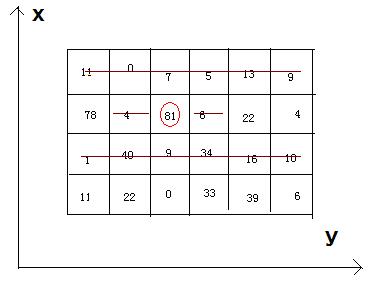hdu 2845 Beans(最大不連續子序列和)
阿新 • • 發佈:2019-02-17
one HERE eating ant output 題意 http itl stream Problem Description
Bean-eating is an interesting game, everyone owns an M*N matrix, which is filled with different qualities beans. Meantime, there is only one bean in any 1*1 grid. Now you want to eat the beans and collect the qualities, but everyone must obey by the following rules: if you eat the bean at the coordinate(x, y), you can’t eat the beans anyway at the coordinates listed (if exiting): (x, y-1), (x, y+1), and the both rows whose abscissas are x-1 and x+1.

Now, how much qualities can you eat and then get ?

Now, how much qualities can you eat and then get ?
Input There are a few cases. In each case, there are two integer M (row number) and N (column number). The next M lines each contain N integers, representing the qualities of the beans. We can make sure that the quality of bean isn‘t beyond 1000, and 1<=M*N<=200000.
Sample Input 4 6 11 0 7 5 13 9 78 4 81 6 22 4 1 40 9 34 16 10 11 22 0 33 39 6 Sample Output 242 題意:在圖中取數,例如取了81之後,同一行的相鄰兩個不能取,還有81的上面那行和下面那行也不能取,問能取到的最大和是多少? 思路:分別求行列的最大不連續子序列和
#include <cstdio> #include<map> #include <iostream> #include<cstring> #include<bits/stdc++.h> #define ll long long int #define M 6 using namespace std; inline ll gcd(ll a,ll b){return b?gcd(b,a%b):a;} inline ll lcm(ll a,ll b){return a/gcd(a,b)*b;} int moth[13]={0,31,28,31,30,31,30,31,31,30,31,30,31}; int dir[4][2]={1,0 ,0,1 ,-1,0 ,0,-1}; int dirs[8][2]={1,0 ,0,1 ,-1,0 ,0,-1, -1,-1 ,-1,1 ,1,-1 ,1,1}; const int inf=0x3f3f3f3f; const ll mod=1e9+7; int sum[20007][2]; int main(){ ios::sync_with_stdio(false); int m,n; while(cin>>m>>n){ for(int i=1;i<=m;i++){ for(int j=1;j<=n;j++){ cin>>sum[j][0]; } for(int j=2;j<=n;j++) sum[j][0]=max(sum[j][0]+sum[j-2][0],sum[j-1][0]); sum[i][1]=sum[n][0]; } for(int i=2;i<=m;i++) sum[i][1]=max(sum[i][1]+sum[i-2][1],sum[i-1][1]); cout<<sum[m][1]<<endl; } }
hdu 2845 Beans(最大不連續子序列和)
